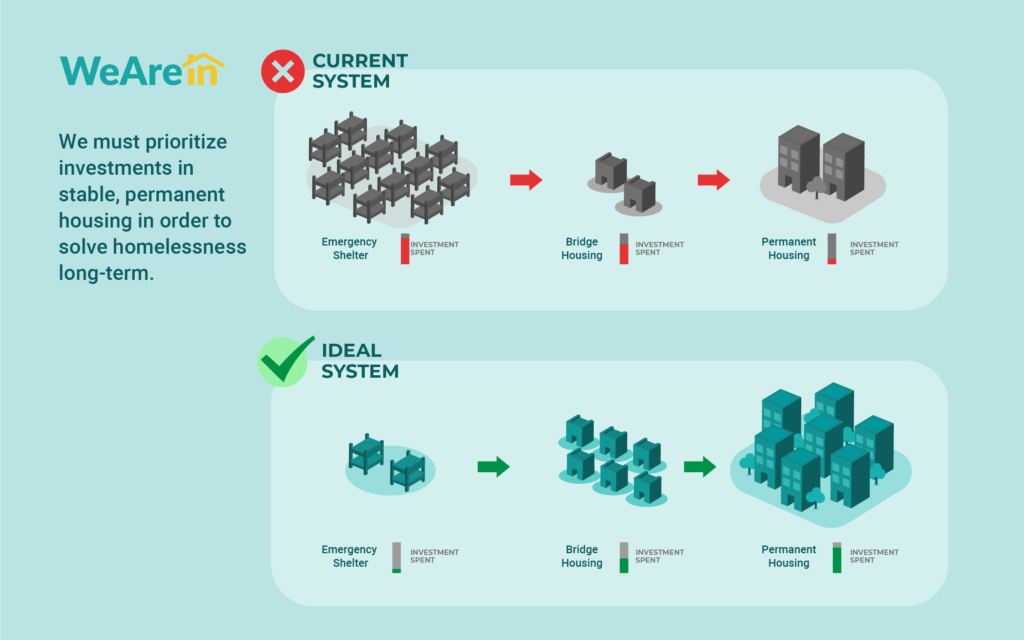Empathy Is Key In Our Fight to End Homelessness
By: Felicia Salcedo, We Are In Executive Director
Solving homelessness is consistently the most important issue for people in King County. This sense of urgency and concern can drive much-needed change –– and the path forward is clear: more affordable, permanent housing and genuine care for people experiencing homelessness. The people most impacted by homelessness are our most critical partners in this work, yet they are often shamed and scapegoated for the very existence of homelessness in our communities. The fight to end homelessness can’t be just about home values, or election victories, or cleaning up our streets –– it has to be about supporting the most vulnerable among us and ensuring a better future for us all by rooting out the structural conditions that allow people to become homeless in King County.
As an op-ed in the Washington Post aptly put it: “smart policy on homelessness requires empathy.”
Often, we talk about homelessness –– and the urgent need to act –– not because our neighbors’ lives and dignity depend on it, but because voters are fed up. Many find it easier to blame individuals experiencing homelessness, acting as though it is a choice, rather than being honest about the fact that the causes are structural (e.g. structural racism, housing market conditions). And media coverage of the issue often focuses more on political infighting among those with the power to make a difference, instead of staying focused on the people and issues for which they’re fighting.
None of that will truly move the needle on this issue. What we need is radical empathy and love for our neighbors –– that is what will fuel the bold change we need to see.
As I was reading that op-ed, I was reflecting on the meaning and purpose of our organization, We Are In. “We” are a community coalition of King County’s unhoused and housed neighbors, advocates, philanthropies, service providers, and businesses, all united in the fight to create more affordable homes and end homelessness in our region. We believe in our shared responsibility and opportunity to support our neighbors and build a stronger, safer community for everyone.
We Are In’s work consists of advocacy, education, and sourcing capital for effective solutions –– we’re also cultivating the empathy and compassion that will continue to drive this movement forward by:
- Uplifting the voices, stories, and leadership of folks with the lived experience of homelessness. Empathy is about learning and understanding the experiences of others. We need to listen to those most impacted and challenge ourselves to think about homelessness from their perspective, not ours.
- Changing the narrative around homelessness and housing so that we’re centering the people most impacted, amplifying progress, and remaining focused on the why: getting everyone in our community into safe, stable, and dignified housing.
- Encouraging folks to get involved in the community and connecting them to opportunities to support our neighbors. We Are In is about taking action, together. We all have a role to play in ending homelessness in our region, and it starts with simple acts of kindness and service. We always share ways to get involved in our newsletter (sign up here) –– if you’re looking to give, check out this article detailing what homeless service providers could use in King County or you can volunteer your time.
Importantly, our collective sense of urgency and care is already driving real progress. Over the past two years, our region centralized the funds and strategy for addressing homelessness through an innovative, independent agency: The King County Regional Homelessness Authority (KCRHA).
The KCRHA, with support from We Are In’s coalition of business and philanthropic partners, launched Partnership for Zero (PFZ), a public-private collaboration to dramatically reduce unsheltered homelessness in targeted areas of King County, starting with Downtown Seattle and the Chinatown/International District. As part of PFZ’s approach, formerly homeless outreach workers, known as System Advocates, are currently helping to secure long-term, stable housing for every person living outside in these areas.
And in June, King County’s Health Through Housing Initiative opened its fifth site in Northgate. With this new site, the initiative has now created nearly 500 available units, bringing us one step closer to getting all of our region’s unhoused residents inside and connected to the services they need to thrive.
We will continue to build on this progress, not only by increasing our stock of available, affordable housing, but also by inspiring others to act with empathy –– we can all be part of the solution.


